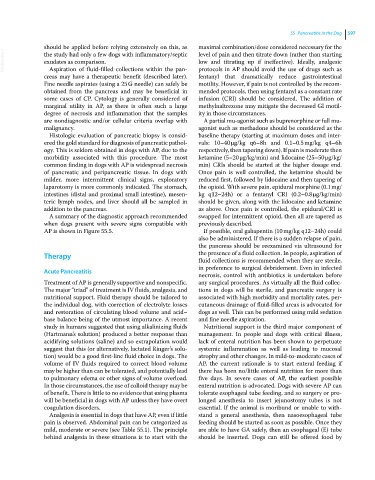Page 629 - Clinical Small Animal Internal Medicine
P. 629
55 Pancreatitis in the Dog 597
should be applied before relying extensively on this, as maximal combination/dose considered necessary for the
VetBooks.ir the study had only a few dogs with inflammatory/septic level of pain and then titrate down (rather than starting
low and titrating up if ineffective). Ideally, analgesic
exudates as comparison.
Aspiration of fluid‐filled collections within the pan-
fentanyl that dramatically reduce gastrointestinal
creas may have a therapeutic benefit (described later). protocols in AP should avoid the use of drugs such as
Fine needle aspirates (using a 25 G needle) can safely be motility. However, if pain is not controlled by the recom-
obtained from the pancreas and may be beneficial in mended protocols, then using fentanyl as a constant rate
some cases of CP. Cytology is generally considered of infusion (CRI) should be considered. The addition of
marginal utility in AP, as there is often such a large methylnaltrexone may mitigate the decreased GI motil-
degree of necrosis and inflammation that the samples ity in those circumstances.
are nondiagnostic and/or cellular criteria overlap with A partial mu‐agonist such as buprenorphine or full mu‐
malignancy. agonist such as methadone should be considered as the
Histologic evaluation of pancreatic biopsy is consid- baseline therapy (starting at maximum doses and inter-
ered the gold standard for diagnosis of pancreatic pathol- vals: 10–40 μg/kg q6–8h and 0.1–0.5 mg/kg q4–6h
ogy. This is seldom obtained in dogs with AP, due to the respectively, then tapering down). If pain is moderate then
morbidity associated with this procedure. The most ketamine (5–20 μg/kg/min) and lidocaine (25–50 μg/kg/
common finding in dogs with AP is widespread necrosis min) CRIs should be started at the higher dosage end.
of pancreatic and peripancreatic tissue. In dogs with Once pain is well controlled, the ketamine should be
milder, more intermittent clinical signs, exploratory reduced first, followed by lidocaine and then tapering of
laparotomy is more commonly indicated. The stomach, the opioid. With severe pain, epidural morphine (0.1 mg/
intestines (distal and proximal small intestine), mesen- kg q12–24h) or a fentanyl CRI (0.2–0.8 μg/kg/min)
teric lymph nodes, and liver should all be sampled in should be given, along with the lidocaine and ketamine
addition to the pancreas. as above. Once pain is controlled, the epidural/CRI is
A summary of the diagnostic approach recommended swapped for intermittent opioid, then all are tapered as
when dogs present with severe signs compatible with previously described.
AP is shown in Figure 55.5. If possible, oral gabapentin (10 mg/kg q12–24h) could
also be administered. If there is a sudden relapse of pain,
the pancreas should be reexamined via ultrasound for
Therapy the presence of a fluid collection. In people, aspiration of
fluid collections is recommended when they are sterile,
in preference to surgical debridement. Even in infected
Acute Pancreatitis
necrosis, control with antibiotics is undertaken before
Treatment of AP is generally supportive and nonspecific. any surgical procedures. As virtually all the fluid collec-
The major “triad” of treatment is IV fluids, analgesia, and tions in dogs will be sterile, and pancreatic surgery is
nutritional support. Fluid therapy should be tailored to associated with high morbidity and mortality rates, per-
the individual dog, with correction of electrolyte losses cutaneous drainage of fluid‐filled areas is advocated for
and restoration of circulating blood volume and acid– dogs as well. This can be performed using mild sedation
base balance being of the utmost importance. A recent and fine needle aspiration.
study in humans suggested that using alkalinizing fluids Nutritional support is the third major component of
(Hartmann’s solution) produced a better response than management. In people and dogs with critical illness,
acidifying solutions (saline) and so extrapolation would lack of enteral nutrition has been shown to perpetuate
suggest that this (or alternatively, lactated Ringer’s solu- systemic inflammation as well as leading to mucosal
tion) would be a good first‐line fluid choice in dogs. The atrophy and other changes. In mild‐to‐moderate cases of
volume of IV fluids required to correct blood volume AP, the current rationale is to start enteral feeding if
may be higher than can be tolerated, and potentially lead there has been no/little enteral nutrition for more than
to pulmonary edema or other signs of volume overload. five days. In severe cases of AP, the earliest possible
In those circumstances, the use of colloid therapy may be enteral nutrition is advocated. Dogs with severe AP can
of benefit. There is little to no evidence that using plasma tolerate esophageal tube feeding, and so surgery or pro-
will be beneficial in dogs with AP unless they have overt longed anesthesia to insert jejunostomy tubes is not
coagulation disorders. essential. If the animal is moribund or unable to with-
Analgesia is essential in dogs that have AP, even if little stand a general anesthesia, then nasoesophageal tube
pain is observed. Abdominal pain can be categorized as feeding should be started as soon as possible. Once they
mild, moderate or severe (see Table 55.1). The principle are able to have GA safely, then an esophageal (E) tube
behind analgesia in these situations is to start with the should be inserted. Dogs can still be offered food by

